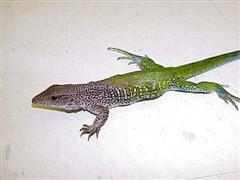Ameiva - Green
Jungle Runner, Dwarf Tegu, Guyana Green Ameiva Scientific Name: Ameiva ameiva
Sat, 16th November, 2024 - 3:51 pm GMT
Sponsor Ads:

Alternative Name
Jungle Runner, Dwarf Tegu, Guyana Green Ameiva Scientific Name: Ameiva ameivaBasic Info
At maturity the Green Ameiva reaches between 38.1 and 50.8 centimeters (15 and 20 inches) in length. The Green Ameiva is quite attractive and has a mottled appearance to its color pattern. The anterior background color is usually dark green, but varies from green to blackish. Posteriorly, the lizard is brown. It typically has white vertical bands along the sides, though coloration and patterns are variable within the species. In some populations, the vertical bands are comprised of yellowish spots. Ameivas have strong legs and long claws that aid them in digging and climbing. Like most ameivas and whiptail lizards, the Green Ameiva has a characteristic pointed snout, a very long tail, and large smooth rectangular scales on its belly.
Health
The Green Ameiva needs a humid environment that can range from high to moderate. It is important to maintain the humidity at a constant level. This can be achieved by misting. How frequently they need to be misted varies greatly depending on the area in which you live. Some will need to mist as often as once or twice a day, while others will only need to mist every three to four days. They should have full spectrum UV lighting for about 13 hours a day. Daytime temperatures should be about 80 degrees Fahrenheit at the coolest end of the enclosure, and they need a warmer basking area about 90 degrees. At night the temperature should be 70 - 75 degrees.Habitat
Mexico and Central and South AmericaBehavior
The Green Ameiva, also known as the "Dwarf Tegu", "Giant Ameiva," or "Jungle Runner" is a popular ameiva in the pet trade. Green Ameivas may be more aggressive than some other ameives such as the Yellow Spotted Ameiva. The Green Ameiva has a reputation for being nippy and will bite if provoked. Males may be territorial, and for this reason, it is often suggested that males not be housed together. In the wild this ameiva lives in tropical rainforests, open forests, woodlands, and agricultural areas and is a terrestrial species. Like most ameivas, the Green Ameiva is a somewhat hyperactive and can be difficult to hold. Their tails may also come off when they are handled, so it is essential that care be taken when they are picked up. In captivity they can be housed in a 55-gallon aquarium, though juveniles may be housed in a smaller enclosure. Make sure to include plenty of logs, plants, and branches for climbing, as well as dark hiding spots. In addition, a thick substrate is recommended because ameivas like to dig and burrow. Water bowls are also a must, for soaking and drinking. In captivity the Green Ameiva does quite well on a varied diet that may include waxworms, mealworms, earthworms, crickets, and pinky mice. Though they are mostly carnivorous, they have been known to eat a piece of fruit occasionally.Origin
Central and South AmericaHistory
Green Ameivas are native to Mexico and Central and South America, though they have been introduced into Florida in the United States.Common Foods
N/ASponsor Ads:
Bad men live that they may eat and drink, whereas good men eat and drink that they may live. -- Socrates
Ameiva - Green
Coded by: BGID® | ALL RIGHTS RESERVED Copyright © 2000-2024
Disclaimer | Privacy | Report Errors / Contact | Credits








 Homosexual behavior stems from the mind or genetics?
Homosexual behavior stems from the mind or genetics?  The Best Text Adventure You Will Ever Play! The official site:
The Best Text Adventure You Will Ever Play! The official site:  Why haven't we as a collective earth met with aliens yet?
Why haven't we as a collective earth met with aliens yet?  World EcoSystem - Biodiversity Changes - Who is on board and who isn
World EcoSystem - Biodiversity Changes - Who is on board and who isn  Mouthwash - Mouthrinse - Mouth Sores - Healing Infections - Gingivitis
Mouthwash - Mouthrinse - Mouth Sores - Healing Infections - Gingivitis  Treatment for Depression
Treatment for Depression  Ultra radical and violent Islamist group that even rivals Al Qaeda
Ultra radical and violent Islamist group that even rivals Al Qaeda  An idea to have teachers who want to carry guns to school undergo some level of police training will be left up to local school districts and police departments.
An idea to have teachers who want to carry guns to school undergo some level of police training will be left up to local school districts and police departments.